Astro Session - November 8, 2018
First shot of the season in the constellation Orion! I set up the AstroTech RC scope (6"/152mm aperture f/9) with my narrowband imaging train, Atik 414EX, ZWO filter wheel with Clear, Ha, OIII, SII & IR685, William Optics 0.8x field flattener/reducer that brings the AT6RC to f/7.2 at 1080mm focal length. With the Atik's 6.45μ pixels this has my resolution at 1.23 arcseconds per pixel, and a field of view of 0.48° x 0.36°.
Here are some shots of my set up last night, before nightfall, and in the middle of the narrowband run with 600-second exposures.
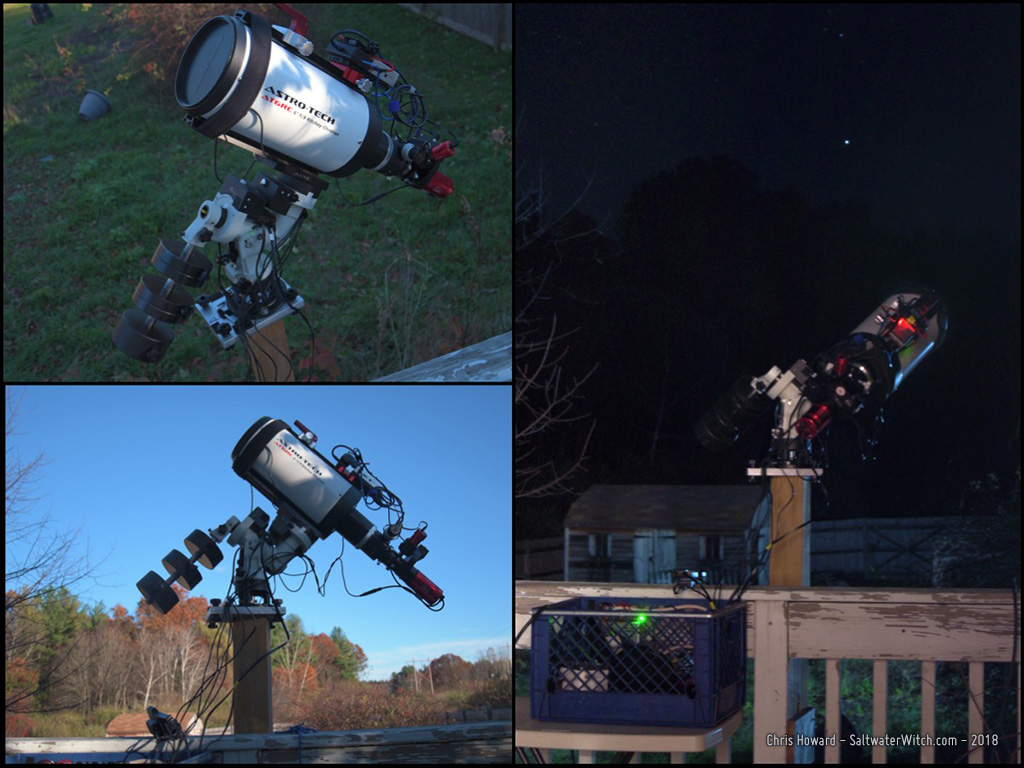
The 1000mm+ focal length did get me wonderfully close to the Horsehead Nebula (B33) and the reflection nebula NGC 2023 (bottom left) in the constellation Orion. This is what 46 stacked 600 second hydrogen-alpha frames will get you if you stretch things a bit too much and don't use any calibration frames. That would reduce the noise/graininess somewhat. Anyway, pretty happy with this. (46 x 600 second exposures in Ha, Atik 414EX mono CCD at -10C, Astronomik 12nm Ha filter, AstroTech AT6RC f/9 Ritchey-Chrétien + WO Flat6A f/7.2, iOptron CEM25P EQ mount, Orion OAG + ZWO ASI120MM-Mini guide cam, Stellarmate OS (INDI/KStars/Ekos) running on Raspberry Pi 3b+. Stacked in DSS, processed in Photoshop CC 2019).
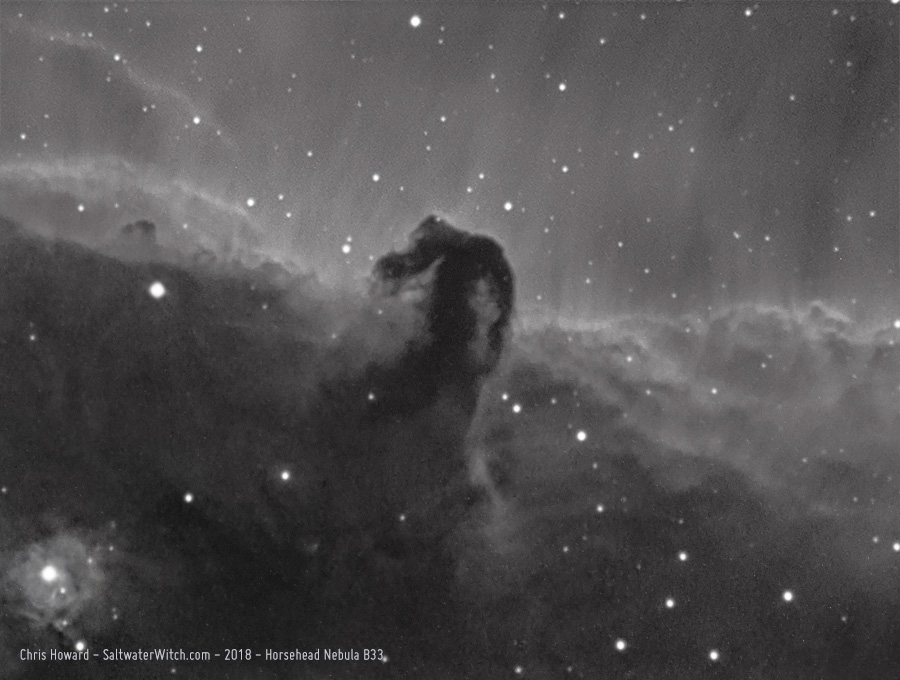
I stretched the hell out of this stack of 46 x 600 second subs, mainly to see what the data would show if I went out of my way to bring out the details. I also didn't use dark frames with this--so that's worth a try. The Atik 414EX at -10C or cooler is very clean, though. I usually don't gain a lot with calibration frames, but in this case even a little will improve the noisiness.
I don't use the AT6RC scope that much, mostly because when paired with the cameras I have the resolution is oversampled crap. The Atik is the only one that's right in there at 1.23 arcseconds/pixel, and that's with the 0.8x field flattener/reducer.
Another point (or set of points) I would like to make is the Astro-Tech 6" f/9 Ritchey-Chrétien is a $400 scope, and I'm pretty impressed with the light and contrast it managed to pull out of the night sky. Some of the credit certainly goes to the Atik CCD, which really is an amazing little camera. The sub-$1000 iOptron CEM25P has no problem with long exposure times. Along with the $129 12nm Astronomik Ha filter, this is a very inexpensive narrowband setup. The point being you don't need to spend a raft-load of cash to start capturing those beautiful HII regions, supernova remnants, and other wonders in the night sky.
My tips for the iOptron CEM25P--or what I've learned over the last two years: For narrowband, I normally shoot 5, 10 or 20 minute subs depending on the brightness of the target, and the iOptron has no problem. However, there are a few steps I go through in order to get very long exposures from this mount. 1) a solid foundation--solid tripod or better. I don't have a concrete or steel pier, but I do have a treated 4x4 solidly in the ground, and it doesn't move. 2) More counterweights, closer to the center of balance. I try to use more weight, and keep them as close to the top of the counterweight shaft as possible. I know it's tempting to use fewer weights farther out, but trust me on this--and don't worry about the bushings that carry all the weight. They can handle far more than you'll ever bolt on. It's minor, but it does smooth out tiny movements the scope has to make--so improved guiding. 3) Balance, balance, balance. You want a perfectly balanced scope and equipment. Don't bias weight to one side; don't get your gear "close enough". If you'll permit me to anthropomorphize the CEM25P for a moment, you want the mount and motors to think they're moving nothing at all, and for that you'll need to balance the shit out of your payload. I use small 100g camera gimbal weights to even the load--balance is that important. (https://www.amazon.com/gp/product/B0797S81HR)
Okay, I also took some subs of the Triangulum Galaxy core (M33) while setting up and getting into focus--testing out shooting in 2x2 binning, which reduces the resolution by half.
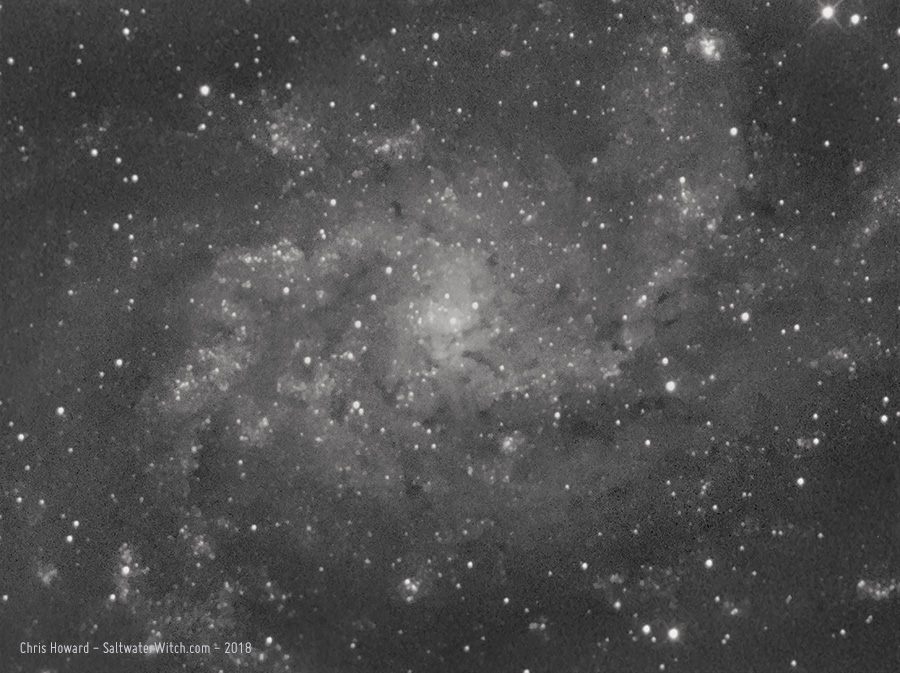
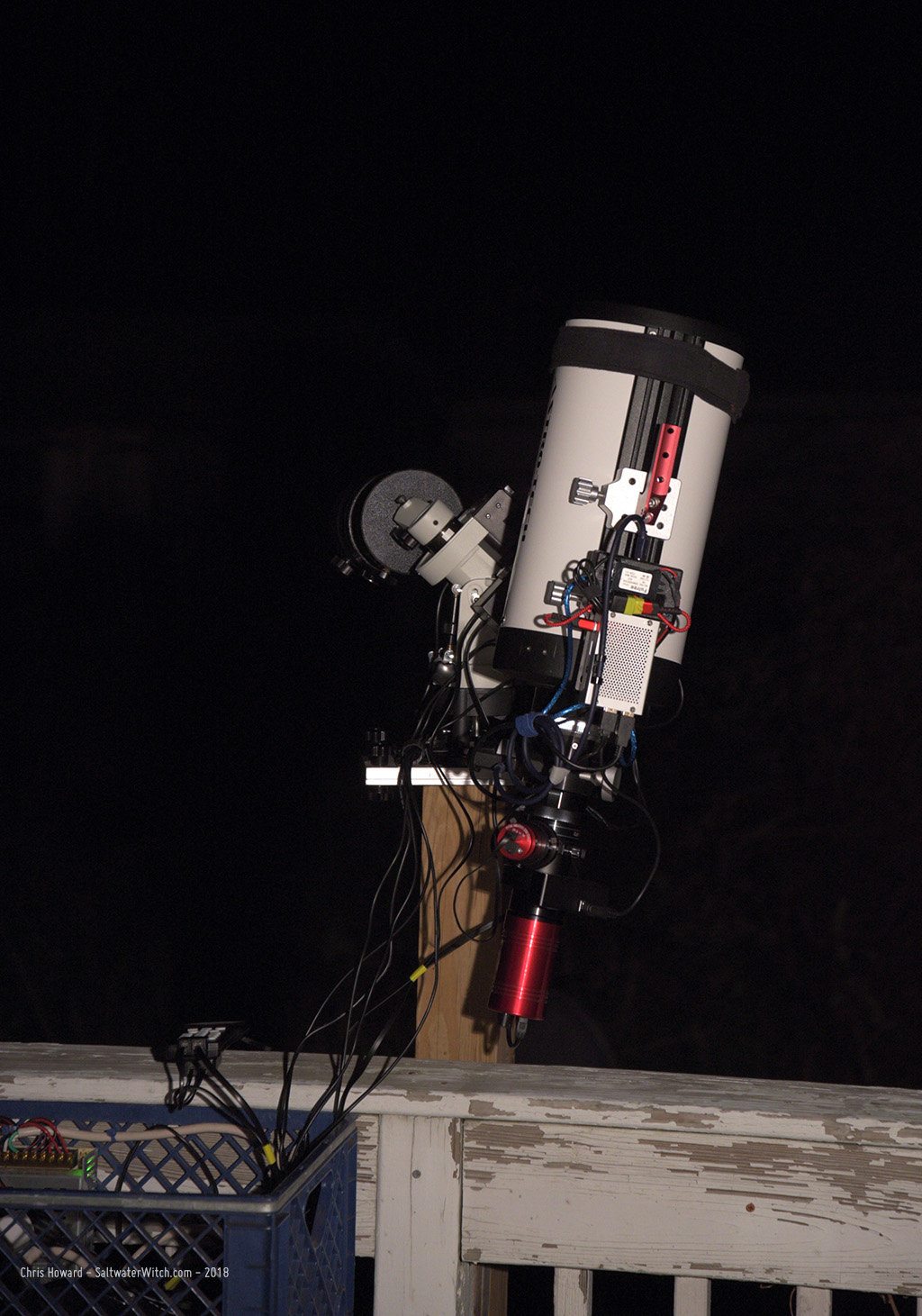
Posted November 9, 2018
Astro Session: October 12, 2018
Wide-field of the Wizard Nebula surrounding the open star cluster NGC 7380 in the constellation Cepheus, about 7,200 lightyears aways from us. I reduced the saturation so that you hardly notice the differences in the RGB mix, mostly R and B because this is a bi-color set with Ha and OIII. I think I prefer this reduced color or even a completely desaturated (grayscale) version. There are so many stars in this image and I'm not a fan of the off-color red and blue stars you get with narrowband. Also in this shot, I particular like the dark band at the top left. These "dark fog" or dark nebula regions consist of interstellar gas and dust that absorb the light from surrounding stars, and the constellation Cepheus has some famous dark cloudy areas, B 174, 150, and several around IC 1396. (16 x 300 second exposures in Ha and OIII, Atik 414EX mono CCD, Astronomik 12nm Ha, OIII filters, William Optics ZS61 + WO Flat F6A f/4.7, CEM25P EQ mount, Orion OAG + ZWO ASI120MM-Mini guide cam, Stellarmate OS (INDI/KStars/Ekos) running on Raspberry Pi 3b+).

Posted October 12, 2018
Astro Session: July 18, 2018
Here's NGC 281 ("Pacman Nebula") in the Hubble Palette (SII, Ha, OIII -> RGB). NGC 281 is an emission nebula, about 9,200 lightyears away in the constellation Cassiopeia. I re-stacked and reprocessed some hydrogen-alpha, oxygen-3, and sulphur-2 image data I shot several months ago, and I'm happier with this latest result than I was then. It's called the Pacman Nebula because it sort of looks like the classic video game character. (6 x 1200 second exposures in Ha, 5 x 1200 sec OIII & SII with 16 dark frames, Atik 414EX mono CCD, Astronomik 12nm Ha, OIII, SII, William Optics GT81, CEM25P EQ mount, WO 50mm guidescope with ZWO ASI120S-MM guide cam, INDI/KStars/Ekos observatory control).
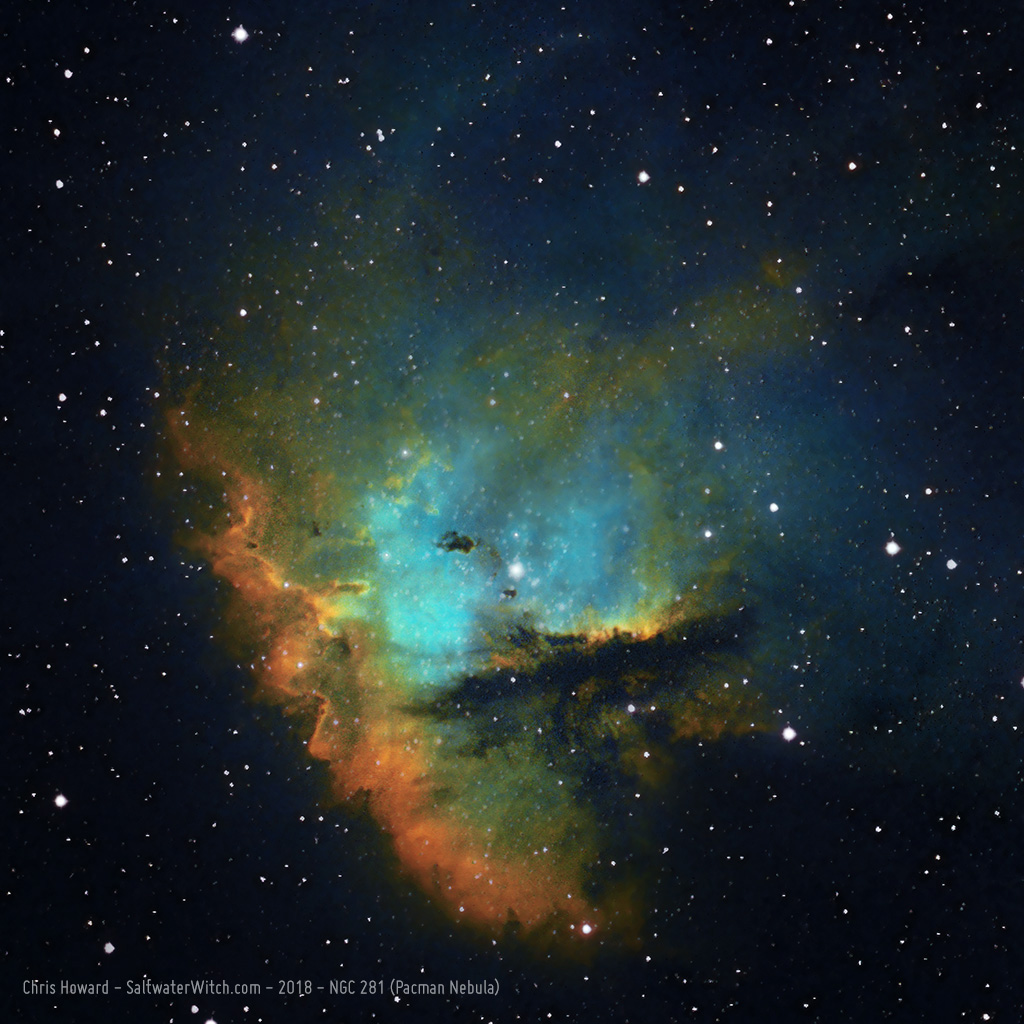
Posted July 18, 2018
Astro Session: July 3, 2018
 The Dumbbell Nebula (M27, NGC 6853), also called the Apple Core, is a planetary nebula in the constellation Vulpecula. I setup the AstroTech with 1350mm focal length, paired with the Atik 414EX mono CCD. This gives me .98" / pixel resolution and oversampling, but still managed to get some detail out of the nebula. (Imaging info: 63 x 90 second subs in OIII, 96 x 60 sec. subs of Ha. + 20 dark frames stacked in Nebulosity, processing in PSCC2018. Equipment: AstroTech AT6RC f/9 Ritchey-Chrétien, Atik 414EX mono CCD, 7nm Optolong 2" Ha filter, 8.5nm Baader 2" OIII filter, Orion Atlas EQ-G Mount, ZWO ASI120MM-S Guide Cam + WO 50/200mm guide scope)
The Dumbbell Nebula (M27, NGC 6853), also called the Apple Core, is a planetary nebula in the constellation Vulpecula. I setup the AstroTech with 1350mm focal length, paired with the Atik 414EX mono CCD. This gives me .98" / pixel resolution and oversampling, but still managed to get some detail out of the nebula. (Imaging info: 63 x 90 second subs in OIII, 96 x 60 sec. subs of Ha. + 20 dark frames stacked in Nebulosity, processing in PSCC2018. Equipment: AstroTech AT6RC f/9 Ritchey-Chrétien, Atik 414EX mono CCD, 7nm Optolong 2" Ha filter, 8.5nm Baader 2" OIII filter, Orion Atlas EQ-G Mount, ZWO ASI120MM-S Guide Cam + WO 50/200mm guide scope)
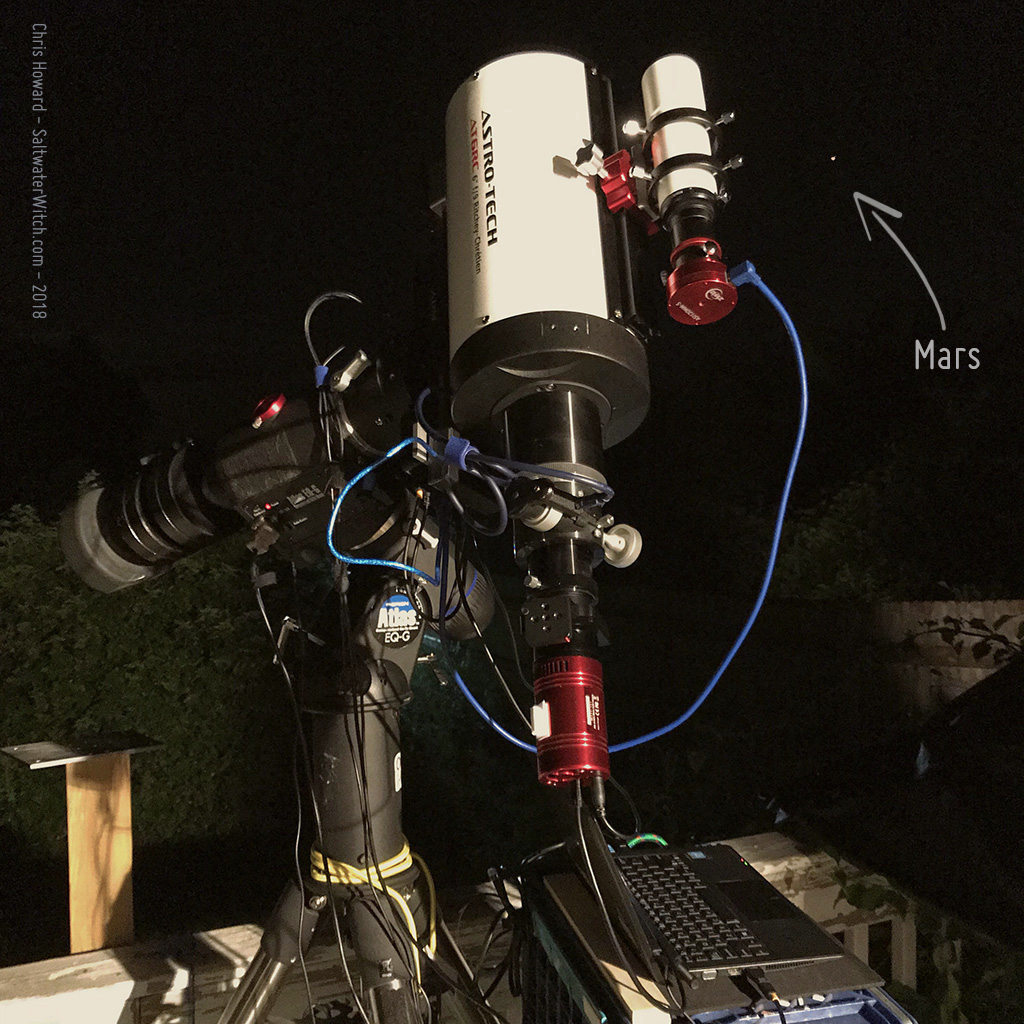
Posted July 3, 2018
Astro Session: June 30, 2018
The Eagle Nebula (Messier 16, NGC 6611, Star Queen Nebula) is an open star cluster and emission nebula in the constellation Serpens, about 7000 lightyears away from us. Imaging Info: 96 x 240 sec. Ha + 42 x 240 sec. OIII frames stacked in DSS, processed in PSCC2018. These frames were taken over several nights. You can see the numbers are a bit unbalanced, but the clouds moved in during the OIII sequence last night, and there was nothing I could do. I went ahead and stacked and processed them as they are. I'll probably come back to this one in the future with more oxygen-3 (and maybe sulphur-2) to achieve something like the actual proportional levels of light from the nebula across these bandpasses. Equipment: William Optics ZS61, Atik 414EX mono CCD, 12nm Astronomik Ha filter, 12nm Astronomik OIII filter, CEM25P EQ Mount, ZWO ASI120MM-S Guide Cam + Orion TOAG, INDI/KStars/Ekos control software. Location: Stratham, New Hampshire, Bortle: 4, SQM: 20.62 https://www.astrobin.com/353803

Posted June 30, 2018
Astro Session: June 22, 2018
The view from my backyard, with the right equipment focused on a particular part of the sky: Cygnus Wall region of NGC 7000, the North America nebula, imaged in narrowband Ha and OIII. The way narrowband imaging works is by filtering out all light except for an allowed narrow bandpass at specific locations in the electromagnetic spectrum. A hydrogen-alpha (Ha) filter will only allow light to pass through to the camera sensor around 656 nanometers, which is out at the red end of the spectrum, and an oxygen-3 (OIII) filter will only allow light to pass through around 501nm, which is in the middle of the blue and green ranges. When I say red, green, blue, I'm talking about where these bandpass lines fall within the scope of the visible spectrum, which starts around 390 and goes to 700 or so (for humans). I shot the oxygen-3 sub-exposures last week, and the hydrogen-alpha subs last night. When you process these separately filtered images into one color image, you may get the Ha coming out vivid red to rust red, and the OIII coming out in blues and greens. The Cygnus Wall is that bright, rolling line across the middle where you have a lot of concentrated star formation, but this area of NGC 7000 also has lot of dust and debris drifting in front of it--the dark reddish-brown regions across the top and right side. (Imaging info: 42 x 300 second subs in OIII, 40 x 300 sec. subs of Ha. + 20 dark frames stacked in DSS, processing in PSCC2018 + Astronomy Tools actions & Annie's Astro actions. Equipment: William Optics ZS61, Atik 414EX mono CCD, 7nm Optolong 2" Ha filter, 8.5nm Baader 2" OIII filter, CEM25P EQ Mount, ZWO ASI120MM-S Guide Cam, https://www.astrobin.com/352528).

Posted June 22, 2018
Astro Session: June 16, 2018
It was narrowband time last night in the backyard. I took a couple hours of hydrogen-alpha (Ha) sub-exposures of M17, the Swan Nebula in the constellation Sagittarius. M17 is about 5,500 light-years away. It's also called the Omega Nebula, Checkmark Nebula, and sometimes the Horseshoe Nebula, but all I see is a swan--with a black beak, neck arched forward, and wings outstretched. The bright region in the middle is the swan's chest. I started to take a few OIII frames on the 16th, but by that time M17 was heading back toward the southern horizon, and so I jumped over to the "Cygnus Wall" in NGC 7000 (North America Nebula). I captured several hours of OIII data there, amazing stuff, and I've already posted the finished image in Ha and OIII. I came back to M17 on the 21st, and took another 40 x 300 second subs in OIII. (M17 info: Ha 16 x 300 second + 82 x 120 second exposures + 20 dark frames, OIII 40 x 300 second exposures + 20 dark frames, stacked in DSS, William Optics ZS61, Atik 414EX mono CCD, 7nm Optolong 2" Ha filter, 8.5nm Baader 2" OIII filter, CEM25P EQ Mount, QHY5III178 guide cam with the Orion TOAG, https://www.astrobin.com/352947).
UPDATE: The Swan Nebula (M17) bi-color narrowband with the WilliamOptics ZS61 and the Atik 414EX. I shot the hydrogen-alpha frames on June 16th (16 x 300 second exposures + 82 x 120 second exposures) and I came back on the 21st to shoot 40 x 300 second exposures in oxygen-3. I decided not to shoot sulphur-2 frames based on the wonderful result with bi-color for my Cygnus Wall image set (6.8 hours of Ha + OIII). For the Swan Nebula (this post) and Cygnus Wall (last post) images I used the Hydrogen-alpha/Oxygen-3 bi-color process developed in an article by Travis Rector, et. al. in The Astronomical Journal here: https://doi.org/10.1086/510117, and detailed here: https://www.starrywonders.com/bicolortechniquenew.html

Posted June 16, 2018
Astro Session: June 2, 2018
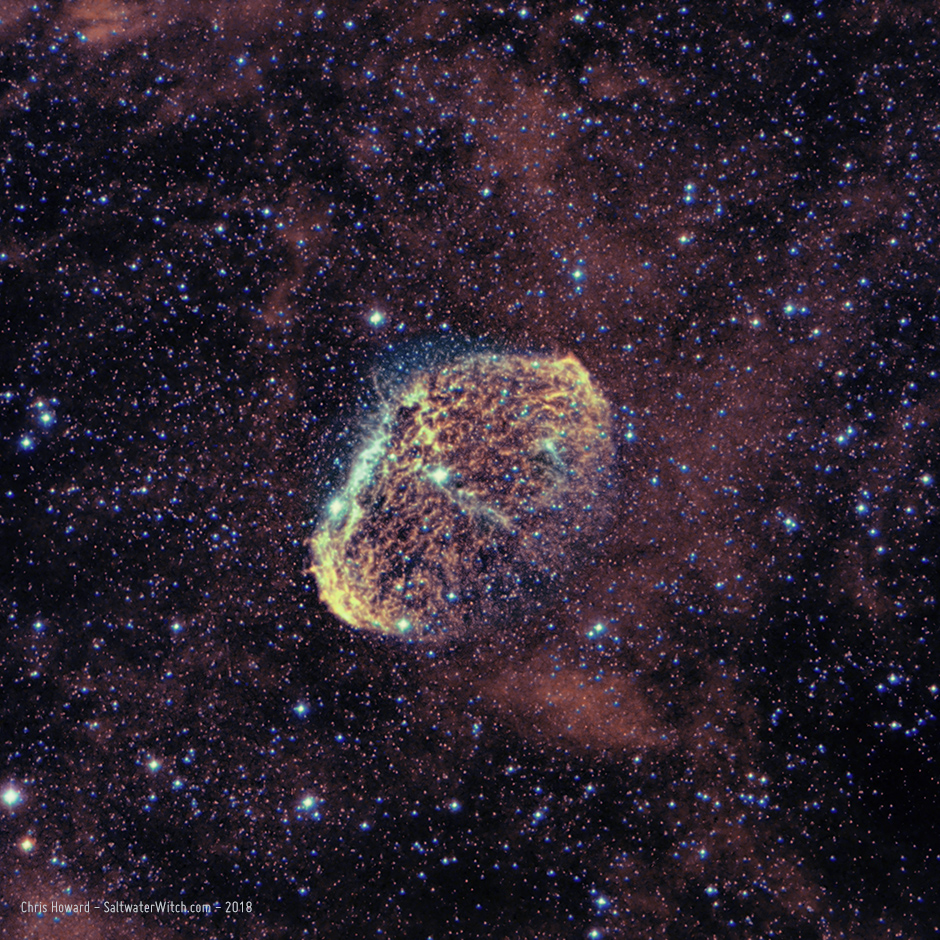 The Crescent Nebula (NGC 6888) with two channels, hydrogen-alpha and oxygen-three. 4 x 1200 second exposures for the Ha (mostly red channel), and 10 x 600 second exp. for the OIII (mostly blue channel). I didn't get nearly enough of the blue halo around the Crescent as I would have liked. I'll probably need to go to 20-minute exposures in OIII next time--or more 10 minute ones.
The Crescent Nebula (NGC 6888) with two channels, hydrogen-alpha and oxygen-three. 4 x 1200 second exposures for the Ha (mostly red channel), and 10 x 600 second exp. for the OIII (mostly blue channel). I didn't get nearly enough of the blue halo around the Crescent as I would have liked. I'll probably need to go to 20-minute exposures in OIII next time--or more 10 minute ones.
